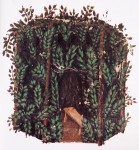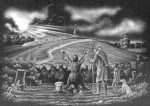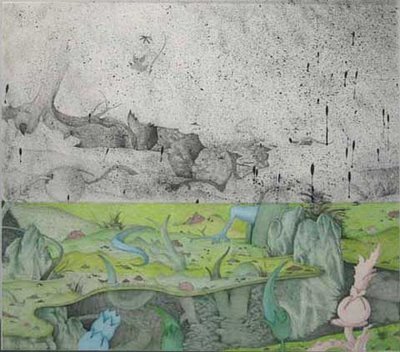
A Midrash of the Jews of Yemen dating from the 13th century provides the following explanation for the mystery of the four-branched shin. There is one “head” for each of the following facets: cogitation, imagination, memory, and estimation.[ref]paraphrasing Midrash haBeur, translated in Yemenite Midrash: Philosophical Commentaries on the Torah, edited by Y. Tzvi Langermann, p. 242.[/ref] Additionally, the midrash provides the following astrological explanation for the three and the four branched shin appearing together on the tefillin shel rosh: together their seven heads make up the seven visible wandering stars (i.e., the planets), whose celestial powers in Jewish cosmology must have one root in the mind of G!d. . . . → Continue reading: All Streams, One Source: Shesha and the Mystery of the Four-headed Shin

Petru Moldovan writes, “Idel notices that in “Ghet ha-Îemot,” Abulafia had used for the first time the gematria combination: Elohim = ha-Teva. To Abulafia, Elohim is the act of Creation, and not its agent, as this name is the same with nature, and the gematria combination should not be understood as a simple linguistic pun, but as a way of considering the identity of nature with the divine, just as Maimonides had suggested it in the “Guide.” . . . → Continue reading: Great Nature and the Gematria of Elohim

Jeff Anshalem writes, “On Shabbat Ḥol Hamoed Sukkot we read of the giving of the Ten Commandments on Mt. Sinai, seemingly a strange choice for Sukkot, but the Maor VeShamesh explains what’s common to both: unity. Unity between us, symbolized by the joining together of the Four Species (Vayikra Rabbah 30:12), evokes unity between us and G!d.” . . . → Continue reading: The Sign of the Twins: On the Reconciliation of the Divine with its Likeness

While working on some curriculum for the Teva Learning Alliance this summer, I was introduced to the Tseno Ureno, an amazing medieval commentary on the Torah by Rabbi Yaakov ben Yitsḥak Ashkenazi (1550-1625). Here’s Rabbi Yaakov Ashkenazi on Deuteronomy 20:19 — כִּ֤י הָֽאָדָם֙ עֵ֣ץ הַשָּׂדֶ֔ה. This is the verse from which the mitzvah of bal . . . → Continue reading: More on the siaḥ of suaḥ: numinous conversations of trees and other vegetation

A poem for Passover 2011. . . . → Continue reading: The Cutting Reeds

A few weeks ago I was asked on the (Star) Trek Jews list what the Jewish concept of t’shuva means… here is what I wrote for someone who might know very little about Jewish thought and philosophy. I think I would have liked it to have more quotes from sources, TaNaKh, Talmud, and other scholars, . . . → Continue reading: On Potters and Potlings (or On turning forward with one’s head turned backwards)

According to one ancient Jewish tradition, the custom of not eating meat on Shavuot celebrates the vow God made with Noaḥ and his children on Mt. Ararat. Although the vow was witnessed by Noaḥ on Ararat, because Noaḥ’s descendants continued to eat the flesh of an animal with its blood, a suitable partner to the . . . → Continue reading: Let the mountains sing together with joy!

In an age when the possibility of living in the land of Israel is no longer an abstract yearning, at a time when Jerusalem is rebuilt (with a soon to be active light rail system!), and after nearly 2000 years without the physical presence of a Temple nor the daily ministrations of priesthood . . . → Continue reading: Metaphors Liberate Us

A poem inspired by one written by Yonah Lavery-Yisraeli, here. . . . → Continue reading: Maseḥet Yoma, Pereq Shemini

In his 1978 essay, “How to Build a Universe That Doesn’t Fall Apart Two Days Later“, Philip K. Dick wrote, “Reality is that which, when you stop believing in it, doesn’t go away.” This ontology is challenged by a syndrome recently brought to my attention in a recent post on boingboing.net, “Hallucinations . . . → Continue reading: Reality and Hallucination: Towards a Talmudic Ontology of Consensus (by way of demons)
|










